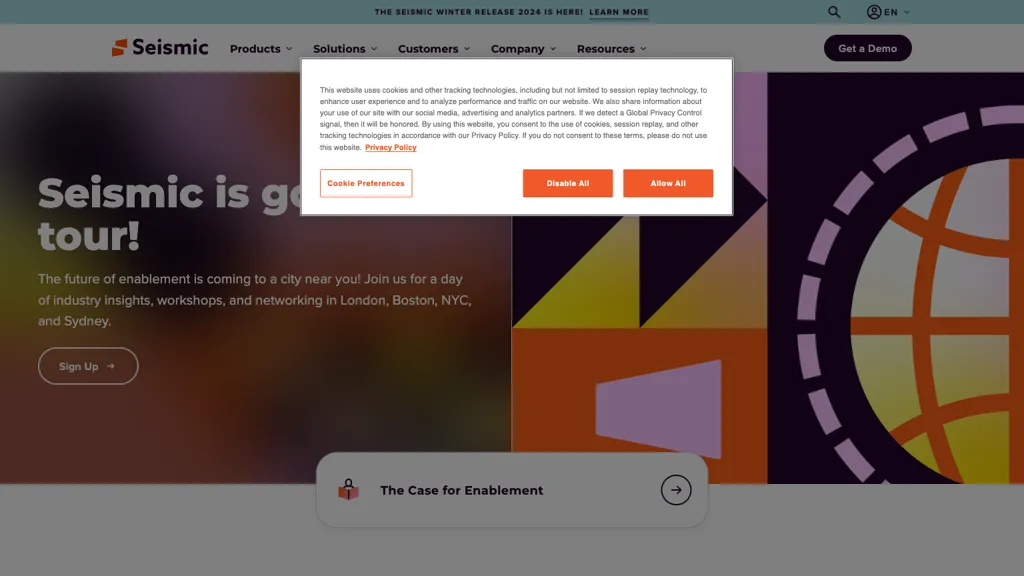What is Seismic?
Seismic is the recognized AI-powered enablement platform that equips global customer-facing teams with the skills, content, and insights they need to deliver frictionless revenue growth. Seismic automates what’s possible in sales content management, buyer engagement, and strategy planning so users can focus on what’s important: driving quota attainment. It further empowers marketing teams with AI-powered recommendations to build impactful content, amplifies customer service through better training and onboarding, and effective content delivery. The best in the business trust it. Seismic showcases marked increase in content utilization, significant time savings per rep per year, and huge growth in revenues from new reps.
Key Features & Benefits of Seismic
AI-enabled platform: Advanced AI mechanisms are deployed in order to optimize a variety of sales and marketing processes.
Sales Content Management: Manage sales content to make it accessible, current, and easy to use.
Buyer Engagement: Develop content and communication strategies to engage buyers.
Strategic Planning: Informs the strategic planning process with data-driven insights and recommendations.
AI suggestions for impactful content: Making AI-powered suggestions on how to create impactful relevant marketing messages.
These capabilities put together help the user smooth operations, increase productivity, and thereby revenue. Seismic is different from others in the set of offerings because not many companies offer AI-driven insight capabilities with wide content management capabilities.
Use Cases and Applications of Seismic
Versatility in application makes Seismic useful across a wide swath of functions and industries, including:
-
Personal selling:
AI-powered personalized selling pitches and recommendations on content by Seismic help in improving conversion rates and increasing revenue. -
Siegfried Lender:
Smarter creation of content-AI-powered suggestions allow marketing teams to create targeted content effectively that gets noticed and drives successful campaigns. -
Improved customer service:
AI in Seismic helps the customer service team with better training of agents and more effective delivery of content for achieving superior customer satisfaction, with quicker response time.
Seismic has very wide applications in sales, marketing, customer success, and revenue growth teams to serve a wide range of user groups.
Log in
Use your organizational credentials to access Seismic.
Overview of Dashboard
A high-level overview of what is available and how to use the various tools.
Organize Your Sales Content
Keep your sales documents up-to-date and at your fingertips.
AI Recommendations
Allow AI to do the work in sorting out what works best to suggest quality content and strategies.
Engage Buyers
Leverage customized content and communication for improving buyer engagement.
Performance Monitoring
Enable tracking and monitoring of content performance and strategies for continuous improvement of results.
Best Practice
Regularly update your content library to make sure that it stays on cadence with changing sales environments and uses Seismic analytics so strategies are always tuned for maximum effect.
How Seismic Works
Seismic is powered by a state-of-the-art AI and Machine Learning Suite:
-
AI-powered content management:
It cures and makes recommendations of the contents regarding relevance and performance with the power of AI. -
Personalisation algorithms:
These personalise content and communication strategies that appeal to buyer profiles and behaviors. -
Data analytics:
Ingests data and provides insights and recommendations to go about strategic decisions and development of content.
It ushers in the data, lets AI do its job of processing and analyzing and acts on those insights to improve sales and marketing.
Pros and Cons of Seismic
Seismic is lagging in several pros and cons that must be identified:
Pros
- Advanced AI for smoothening and optimizing all processes
- Full facilities for content management
- Buyer engagement increased on account of personalization of content.
- Data-driven insights to drive decisions at scale.
Cons:
- May be hard to initially learn.
- May require integration with a few services for seamless usage.
User feedback has been good in general, where most users cite how it improves efficiency and facilitates revenue growth, although many indicate initial complexity in learning the platform.
Conclusion about Seismic
In short, Seismic is a state-of-the-art, high-tech AI-powered enablement platform that really amplifies the manner in which one conducts sales enablement, content management, and customer engagement. Advanced features bundled with manifold benefits make Seismic so practical for such a wide range of teams, including sales, marketing, and customer service. There’s definitely a learning curve, but unquestionably huge efficiency and revenue growth are felt with this platform. Into the future, change remains standing guard over Seismic as it continues to develop new improvements in its technology.
Frequently Asked Questions about Seismic
What is Seismic?
It is an AI-driven global sales enablement platform that carves a path in the management, engagement of buyers, and planning of strategies regarding sales content.
Who are Seismic’s customers?
It is a platform that addresses many industries that touch on sales, marketing, customer success, and revenue growth teams.
How does Seismic enhance buyer engagement?
Seismic leverages AI to make content and communication strategies more apt and relevant.
How much does Seismic cost?
Seismic has a Basic, Pro, and Enterprise Plan, each available at scale for different team sizes.
What are the best ways to utilize Seismic?
Continually refresh your content library with the latest insights from AI, and performance analytics will keep you tuned at every turn.










